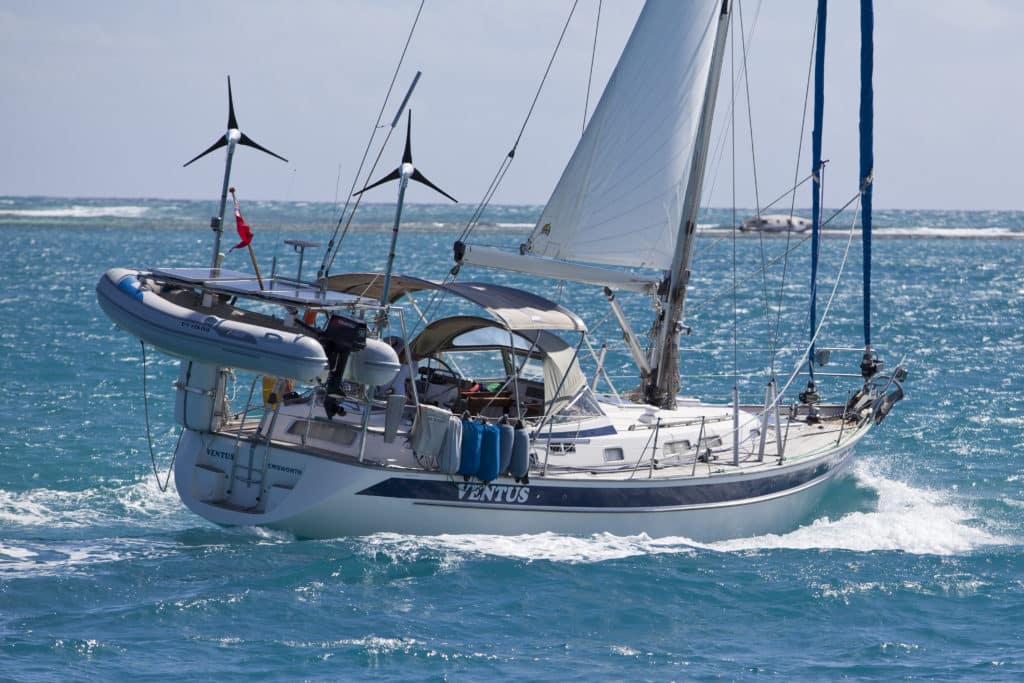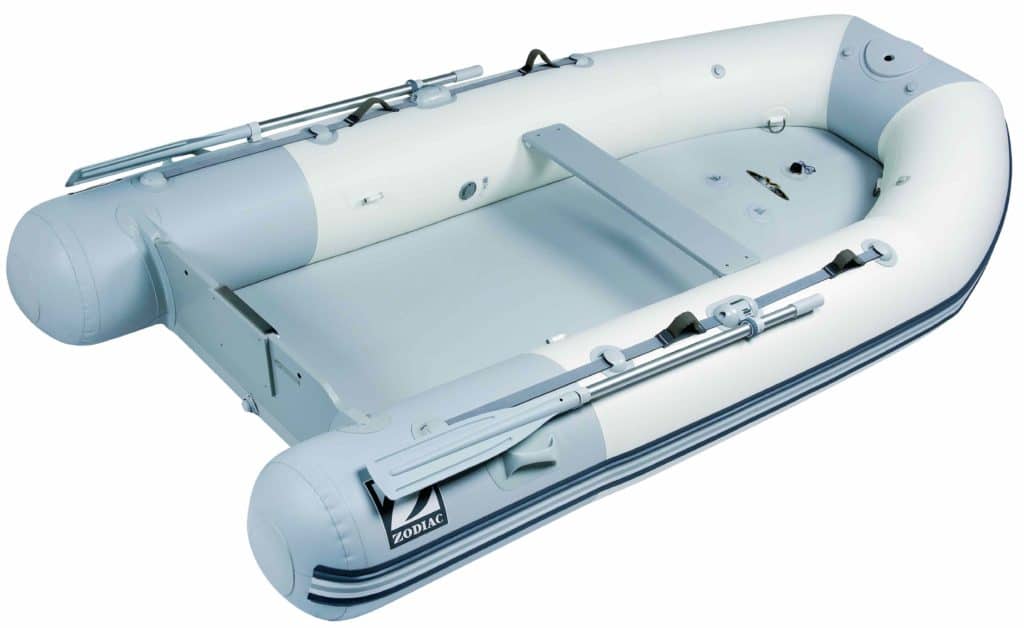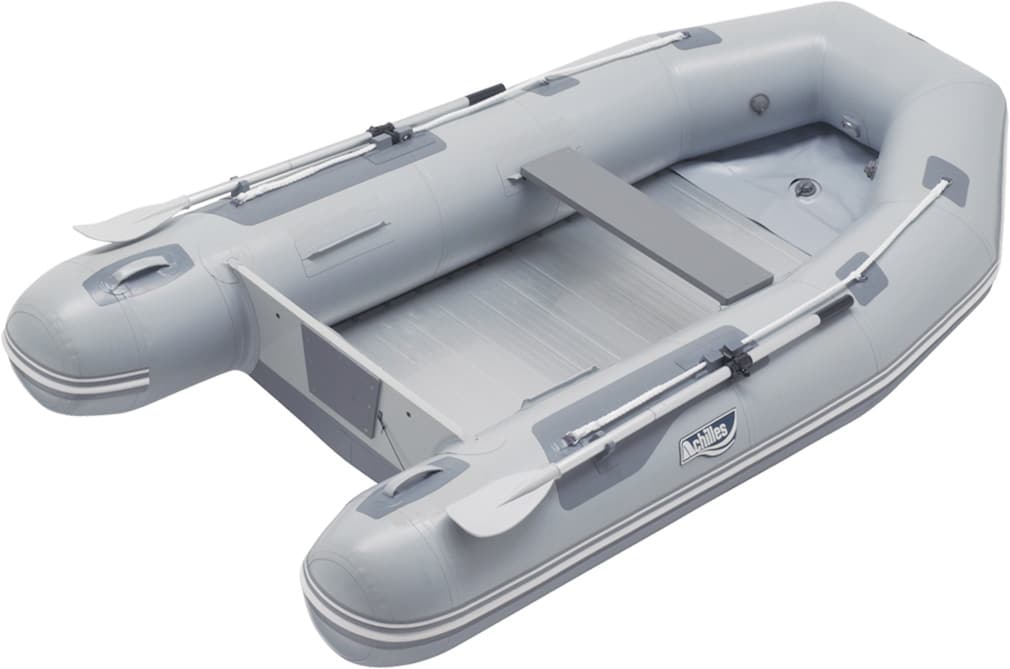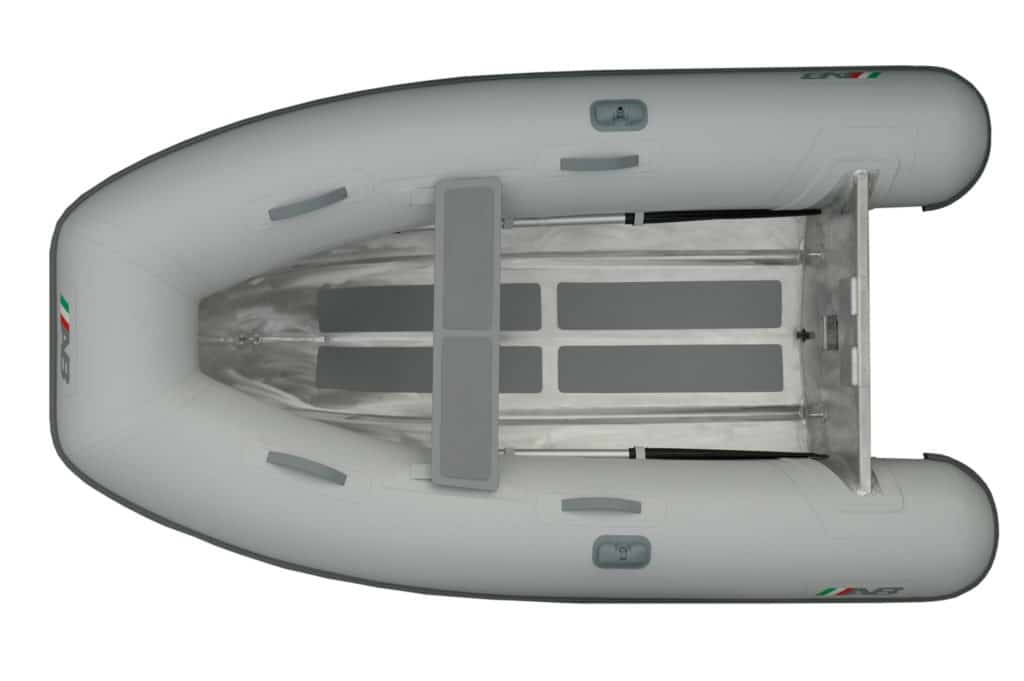
Shopping for a tender is a little like shopping for a car. The options are seemingly endless, and it’s not so much about finding one dinghy that checks every box as it is about finding a dinghy that best fits the type of cruising you plan to do. As Defender’s Stephen Lance puts it, “In my 30-plus years of designing, building, selling, repairing, buying, cutting up and examining inflatable boats, there is only one golden rule: There is no ‘perfect inflatable boat’ for the cruising sailor.” Lance notes that the product landscape is constantly changing, and buyers have to decide which trade-offs are most acceptable for their use.
Inflatable dinghies come in three overarching categories: those with rigid bottoms, those with air floors, and — a sort of hybrid between the two — dinghies with jointed or slatted bottoms. We’ll break down the strengths and weaknesses of each of these options.
Pros and Cons of Air-Floor Dinghies

A dinghy with a high-pressure air floor is a good choice if you plan to roll it up and stow it regularly, and don’t have a lot of space to do it. It has a floor chamber that can be inflated with a hand pump with a pressure gauge (for those who want a 15-minute aerobic workout), or an electric pump that plugs into 12- or 110-volt power. Air-floor dinghies are among the lightest-weight options available, and can be much easier to assemble on board than fitting the slats into a wood floor.
In most models, an inflated keel tube that runs down the centerline helps give the hull a V shape for better tracking. Air-floor dinghies might be especially attractive to bluewater cruisers because they can be easily stored below, where they won’t create windage or be vulnerable to waves breaking over the deck.
It should be noted, though, that proper inflation is key, which might mean pumping in extra air on cool mornings and watching out for overinflation in hot weather. Air floors are not as durable as their solid counterparts, so they might not be the best choice if you plan to frequently haul heavy or sharp-cornered gear. A puncture in an air floor can be difficult to repair, so if you’re headed for remote anchorages, it’s not a bad idea to carry a replacement floor as a spare.
Roll-Up, Slatted and Paneled Floors

A compromise between an inflatable floor and a rigid, fiberglass bottom is one made of wood, aluminum or plastic slats that are either hinged to roll up or come apart in separate panels.
Dinghies with these floor styles are typically nonplaning, don’t tow or track particularly well, and have limited range, but they can fit the bill if you’re just putting around a mooring field. They can also be among the least-expensive inflatable dinghies. Jointed slats are more straightforward to rig and derig because you don’t remove the floor when rolling up the boat. Meanwhile, setting up a plywood-panel dinghy can be time- and labor-intensive, not to mention finicky, and a flat surface is recommended. For this reason, paneled floors are probably best-suited for cruisers who need only to stow and then relaunch their dinghy occasionally. Despite these challenges, former CW senior editor and Practical Sailor editor Darrell Nicholson notes, “The assembly hassles of a plywood floor are offset by having something very durable that I can fix anywhere myself.”
When to Choose a Rigid-Bottom Dinghy

Hard-bottomed inflatables have higher carrying capacities and behave much better as boats, but they are heavier and more expensive than the alternatives. Stowing a rigid-bottomed inflatable can be a challenge because you’ll need davits or foredeck space to lash it down. Some RIBs have a hinged transom that, while less efficient with an outboard, allows the dinghy to lie almost flat when deflated.
When in use, a rigid bottom is likely to be more durable and better able to handle being pulled onto the beach than an inflated floor, and the extra weight and V-shaped hull help the dinghy track better when being towed. Within the RIB category, fiberglass bottoms are the most common, making dinghies durable but heavy. Aluminum bottoms are much lighter but more expensive and susceptible to corrosion.
RIBs can be made with a single or double floor. A single-floor RIB weighs and costs less, but the floor follows the V shape of the hull, making it a bit less stable underfoot. A double-floor RIB has a flat deck, which makes it a more stable and comfortable platform. The watertight air chamber between the deck and hull also provides some extra buoyancy, and as an added bonus, many double-floor RIBs have a locker in the bow to store an anchor or other gear.
Of all the inflatable dinghies, double-floor RIBs have the least overall flex, making them the most efficient design. They can be paired with a more powerful outboard and are an ideal choice if you plan to use your dinghy for adventures farther afield.
Notable Features of Inflatable Dinghies
Polyvinyl chloride (PVC) and chlorosulfonated polyethylene synthetic rubber (commonly known as CSM, or its trademark name, Hypalon) are the two most widely available fabrics for a dinghy’s inflatable pontoons. PVC seams are thermomolded, an automated process that creates a bond that is stronger than the fabric itself. Hypalon seams, on the other hand, must be hand-glued, which is part of the reason why Hypalon inflatables are more expensive than those made of PVC.
West Marine’s Tim Mize notes: “Hypalon is more resistant to damage from UV rays, so if you’re planning to cruise the tropics, it’s the fabric of choice. New England sailors, on the other hand, can save a little money with PVC.”
No matter what fabric you choose, protecting the pontoons with a spray-and-wipe UV protectant or a set of canvas covers (see “Making Dinghy Chaps,” March 2017) can help block the sun’s damaging rays, extending the dinghy’s life. That said, Nic Stark of Annapolis Inflatables points out, “The best first step toward a long life is keeping the boat and tube clean; dirt, salt and sun do the most damage.” Stark adds that covering the boat when not in use also helps.
If you’ll be cruising locations with rough conditions and/or prefer a drier ride, look for tubes with larger diameters. Other features to seek out are handholds placed within easy reach of both driver and passengers, as well as substantial rubbing strakes to protect the pontoons from barnacle-encrusted dock pilings.
Oar design and storage should also be considered; oars low inside the boat are much less likely to go flying than those mounted on top of the tubes. Look hard at where the fuel tank for the outboard will go, and make sure there’s a way to secure it underway.
Good towing-bridle attachment points are critical — if you plan to tow your dinghy. Likewise, if you’re going to hoist it on davits or a halyard, strong D-rings or welded loops will be necessary.
A dink backed by an extended warranty and wide dealer network will cost a bit more, but the ability to find spare parts, make repairs and have it serviced in your intended cruising area is likely a worthwhile trade-off. Read the fine print on your warranty because some can be voided by DIY repairs.
Choosing and Outboard for Your Dinghy
The outboard you choose will depend on how much exploring you want to do, how many people you typically carry, how much gear you’ll need to tote around and, of course, the maximum rating for the dinghy itself.
If you need only to get to shore and back from the mooring and getting on plane is no concern, a 3- to 5-horsepower motor might do the trick. If you’d like to use the inflatable for bigger adventures — or to haul more provisions, gear and fuel — a rigid dinghy with a more powerful outboard will make more sense for you.
On matching the right outboard to your dinghy, CW Boat of the Year judge Ed Sherman notes, “There’s an important difference between the teeth-rattling maximum-horsepower rating stamped on the transom and the more-reasonable horsepower size that the manufacturers usually recommend.” Check the thickness of the dinghy’s transom to make sure your outboard will attach properly.
When it comes down to it, there is no one tender that does it all. The one you choose will depend on the type of cruising you have planned and what kind of space is available for storage. If you plan to tow your dinghy while sailing short, coastal hops, and have plenty of foredeck space or davits, a rigid-bottomed inflatable can’t be beat. But if you’re doing serious offshore passages and/or are on a smaller boat, a stowable tender will be a better fit.
Eleanor Merrill is CW’s managing editor.








